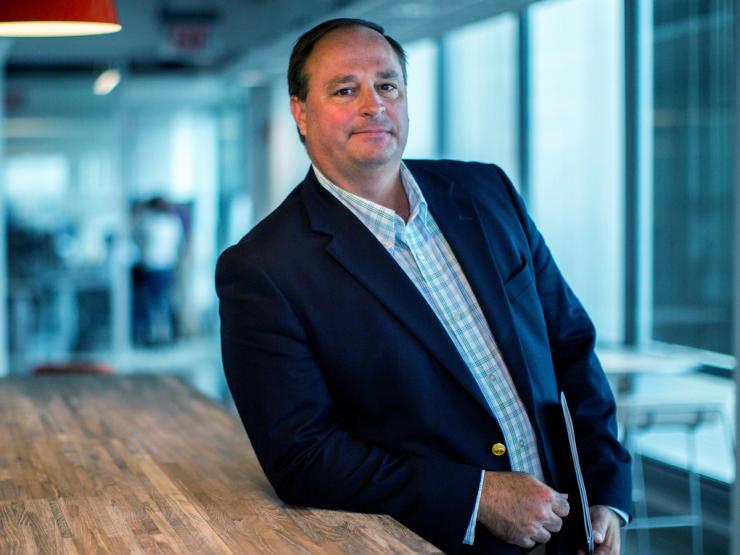The Scene
Brooks Tingle likes to say that nobody, other than your friends and family, wants you to live longer than he wants you to. The Boston-based CEO runs John Hancock, one of the largest US life insurers, and knows that the longer its customers live, the more it can make from investing their premiums before having to pay out to their beneficiaries.
Yet Tingle knows he works in an unloved industry. (If you think about your life insurer at all, “you’re thinking about dying,” he remarks.) About a decade ago, that observation collided with another: Given their alignment of interests, it was odd that John Hancock was doing nothing to encourage healthier habits in its policyholders.
The result was a program called Vitality, which “nudges” John Hancock’s customers to get more exercise, eat healthier food, and go for preventative health screenings. The incentives range from Amazon vouchers and discounted Apple Watches to subsidized cancer screening tests and savings of up to 25% on life insurance premiums.
Tingle says two-thirds of his customers now use Vitality, of whom almost 80% report that their health is similar or has improved since joining. About 45% report body mass index reductions, at least half of those with high blood pressure or high cholesterol have brought their readings into a recommended range, and several have detected cancers early enough to get treatment. Customers’ engagement with John Hancock used to mean little more than opening an annual invoice, but the average Vitality member uses its app more than 20 times a month. Tingle says that has helped John Hancock, the US arm of Canada’s Manulife Financial, outgrow its industry almost every quarter for the past seven years.
In the jargon of his business, Tingle says this focus on prevention and early detection can “bend mortality and morbidity risk curves.” Is Vitality extending its users’ lifespans? All the trends are pointing in the right direction, he says, but “it’s too soon to share actuarily sound data.”
This interview has been condensed and edited for clarity.
The View From Brooks Tingle
Andrew Edgecliffe-Johnson: What was the insight that led you to launch Vitality?
Brooks Tingle: I woke up 10 or 12 years ago, and realized I was a leader in an industry in which nobody got any joy from our products whatsoever. No one thought it was fun to own. You literally bought this thing because you thought you had to. And your interaction with the life insurance company was once a year they’d send you a bill. So I said, gosh, we’re living in this modern digital economy where every experience we have as consumers is more digital, personalized, and engaging, and we can’t continue to just sell this stack of paper that you put in a safe deposit box somewhere. And if you think about us you probably don’t think about us very positively. As you’re paying our bill, you’re thinking about dying.
So on the one hand, we had this desire to modernize the insurance ownership experience to have more engaging relationships with our customers. On the other hand, there was this unmistakable megatrend around behavioral insurance. We saw this phenomenon and [realized] this is the way to drive more engagement in the pursuit of something that’s good for our customers, good for us, and good for society.
And the longer I live, the longer you have holding my premiums, so the more beneficial it is for you?
I make no secret about the fact that, if you’re one of our life insurance customers, I want you to live a long, healthy life. A, because I think it’s the right thing societally, if you’re a nice guy and all that. B, I will make more money. Not only are customers oddly OK with that, they actually like that candor, because now they realize it’s not a gimmick.
When you look at the numbers on Vitality, what’s struck you the most?
The first stat is we’ve gone from engaging with our customers one to two times, to 20 to 30 times a month. [Behavioral change] is not easy. If it was, I would make better choices. My son reminds me I spent my whole life going around talking to people about living longer, healthier, better lives, and don’t do everything myself. But we now have 10 years of data that shows that, with the right incentives and rewards, you can end up with a population of people that, on average, exercise more, eat better, and go for more preventative screenings.
What are the privacy and trust issues when you’re requesting that much data from people?
We have three principles going into this, which have proven to be invaluable. One is complete optionality. You don’t participate in this? You’re not penalized in any way. I use the term carrots and sticks: Sticks actually work pretty well in behavioral science, but we said we’re going to be carrots. The second principle is absolute clarity and transparency of what we do with the data and what we don’t do with the data. We don’t sell it to a third party. We don’t use it to shape your coverage in any way. The premium can only go down. If we find out that you have cancer or something, we’re not going to charge any more. And then the third thing is we say to people, if you’re willing to share this data with us, here’s what you get in return: the Starbucks [vouchers], that [discounted] Amazon Prime membership, the free Apple Watch. And people love that sense of control of being able to monetize their data, because most of us consumers know that every company in the world has a bunch of data about us. We’re not sure where they’re going with it. And I’m sure as heck not getting value back from it, unless you consider targeted ads value.
What do you look for in the people that you appoint to senior roles?
I try not to have them all bring exactly the same things to the table, but technical proficiency is not the most difficult thing to find. What is more difficult to find, and what I really crave and almost insist on, is impatience. Only the most charitable observer would say the insurance industry has been innovative, and the things that we’ve been trying to do with Vitality I think represent the future for an industry that’s hundreds of years old and not that exciting to people, and all of that is incredibly hard. It’s all hard, and to do it, you have to have a burning passion for it, and you have to really believe in what you do.


